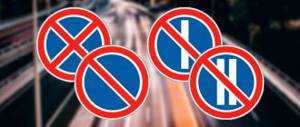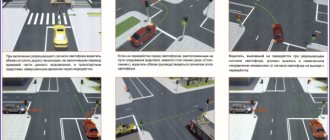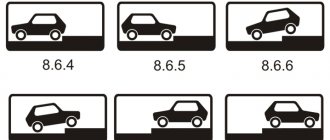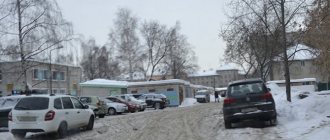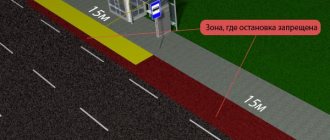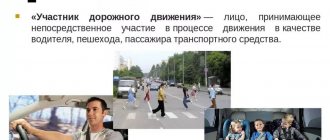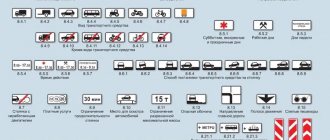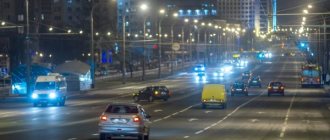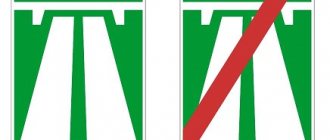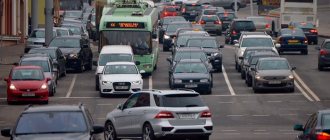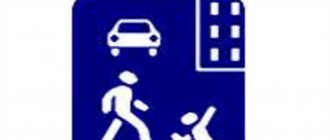Drivers must remember to comply with traffic rules, not only when driving their car, but also when leaving it in parking lots, parking lots, roads, etc. Particular attention should be paid to parking in the oncoming lane. Failure to comply with legal requirements regarding leaving a vehicle in this manner can lead to very unpleasant consequences for motorists in the form of a fine.
To avoid getting into trouble, motorists are encouraged to read the article about the rules for parking in the oncoming lane, as well as the penalties for violating them.
How to stop and park in oncoming traffic correctly
On the left side of the road, and therefore, in the presence of two-way traffic on the oncoming lane, according to clause 12.1 of the Russian Federation Traffic Regulations, it is allowed to stop and park exclusively in populated areas and only on those roads that have one lane each for the oncoming and oncoming directions. An essential condition for legal parking on oncoming traffic is the absence of tram tracks in the middle . In one-way traffic, the same rules apply for stopping and parking on the left as for parking on the right. However, vehicles whose weight exceeds 3.5 tons can stop only when unloading and loading are necessary (for example, bringing goods to a store, delivery service, etc.).
Clause 12.2 of the Russian Traffic Regulations covers the correct methods for parking a vehicle. It says that parking cars on the roads is only allowed in a parking lot parallel to the roadway and in one row . Only two-wheeled vehicles that do not have a side trailer are allowed to park in two rows. In another way, that is, at an angle to the roadway, parking can only be done if there is a permitting road sign depicting the method of parking the vehicle and road markings provided for this section of the road. In addition, the parameters of the roadway section must allow the vehicle to be parked in this way. It stands for parking; if there are no signs specifying how to park the vehicle, the car should only be parked parallel to the roadway, otherwise the rules will be violated.
For cars, motorcycles, mopeds and bicycles, parking may also be permitted on the edge of the sidewalk bordering the roadway, but only if a “Parking” road sign is installed in this place together with one of the signs depicting the permitted method performing a maneuver.
Read more about parking at the pedestrian crossing by following the link.
stopping and parking of vehicles
At railway crossings, the prohibition zone applies to both sides of the railway crossing. In places where only parking is prohibited, stopping is permitted.
See term "Stop". 12.6. If forced to stop in places where stopping is prohibited, the driver must take all possible measures to remove the vehicle from these places. When forced to stop in a place where stopping is prohibited, the driver is required to turn on the hazard warning lights and display an emergency stop sign. But the first thing he must do is take all measures to remove the vehicle from a potentially dangerous place. 12.7. It is prohibited to open vehicle doors if this will interfere with other road users.
In what cases is a maneuver prohibited and what penalties are provided for this?
| Type of offense | Sanction | Rule of law |
| Violation of the rules for stopping and parking a vehicle without qualifying signs. | A warning or a fine of 500 rubles. | Part 5 art. 12.19 Code of Administrative Offenses of the Russian Federation |
| Stopping and parking at railway crossings. | Punishable by a fine of 1000 rubles or deprivation of rights for a period of 3 to 6 months. For committing the same offense again, a driver's license will be suspended for 1 year. | Part 1 art. 12.10 Code of Administrative Offenses of the Russian Federation |
| Parking and stopping in parking spaces provided for disabled vehicles, committed by drivers who do not belong to the category of citizens with disabilities. | Punishable by a fine of 5,000 rubles. | Part 2 art. 12.19 Code of Administrative Offenses of the Russian Federation |
| Stopping and parking a vehicle at a distance of less than 5 meters from or on a pedestrian crossing, as well as violating the rules for parking on sidewalks. | For such an administrative offense you will have to pay 1000 rubles. | Part 3 art. 12.19 Code of Administrative Offenses of the Russian Federation |
| Parking in places designated for stopping route vehicles or passenger taxis, as well as at a distance of less than 15 meters from them. Picking up and disembarking passengers is an exception and is therefore not an offence. | The fine is 1000 rubles. | Part 3.1 art. 12.19 Code of Administrative Offenses of the Russian Federation |
| Stopping and parking on tram tracks, as well as parking of vehicles further than the first row from the edge of the roadway. | Violation of this rule will result in a fine of 1,500 rubles. | Part 3.2 art. 12.19 Code of Administrative Offenses of the Russian Federation |
| Parking on the roadway in violation of the rules, as a result of which obstacles are created for other road users. | Incurs a fine of 2,000 rubles. | Part 4 art. 12.19 Code of Administrative Offenses of the Russian Federation |
The listed fines apply throughout the country, but for some exceptions are made in the cities of Moscow and St. Petersburg.
Thus, on the basis of Part 5 of Art. 12.19 The fine for parking without qualifying signs is 2,500 rubles.
In accordance with Part 6 of Art. 12.19 of the Code of Administrative Offenses of the Russian Federation, the amount of the fine in these cities has been increased to 3,000 rubles. for the following offences:
- parking on a pedestrian crossing or at a distance closer than 5 meters to it, as well as violating the rules of stopping and parking on sidewalks;
- parking at stops for route vehicles and passenger taxis or at a distance of less than 15 meters to them;
- parking on tram tracks or further than the first row from the edge of the roadway;
- creating obstacles for other traffic participants with an incorrectly parked vehicle.
Is it possible to stop on the side of oncoming traffic outside the city?
Outside the city, stopping on the side of oncoming traffic is prohibited. This rule follows from clause 12.1 of the Russian Traffic Regulations, since it states that stopping and parking on the left side is allowed only in populated areas.
If the need to stop on the side of the road in the opposite direction is great, you can turn around (provided that the median strip allows this maneuver) and stop in accordance with all the rules.
Parked your car in oncoming traffic? Are you sure you're not breaking anything?
When parking a car, drivers must strictly follow traffic rules, as this can result not only in a fine, but also in deprivation of their license.
Did you know that you can't always park on the opposite side of the road? Even if the road runs next to your house and you have nowhere else to park your car. See also 7 unwritten rules for drivers
Every evening, many motorists, approaching their home, begin to circle around the courtyards and adjacent streets, hoping to find a place to park their car. But, alas, for example, in many large cities it is very difficult to find a free parking space. It is logical to assume that as a result of such an evening quest, many drivers are ready to park the car wherever and however they want, forgetting about the Rules of the Road, which often backfires on them.
So, let's imagine a situation: you found a parking space on the roadway on the opposite side. Naturally, at this moment many people do not want to drive and look for a U-turn in order to approach a parking space from the opposite side of the road. As a result, forgetting about caution, motorists drive into oncoming traffic and park the car in the opposite direction of traffic on the opposite side of the roadway. At this moment, you will be lucky if there is no traffic police crew nearby. Otherwise, the driver may face administrative liability for driving into the oncoming lane in violation of traffic rules.
See also: This is why parking on the sidewalk in the yard can result in a large fine
But even if such a maneuver with entering a parking lot goes unnoticed, the driver still risks running into a fine not only for violating the rules of stopping or parking vehicles. For example, in the morning, when a car parked in the direction of oncoming traffic begins to drive onto the road, the driver may violate traffic rules by driving into the oncoming lane. And according to the law of meanness, this violation can be recorded by traffic police officers. By the way, for your information: traffic police crews like to keep watch over such drivers in the morning hours. Guess why.
It is worth noting that the Traffic Rules in some cases still allow cars to be parked on the opposite side of the road. To do this, let's remember clause 12.1 of the traffic rules:
12.1. Stopping and parking of vehicles is permitted on the right side of the road on the side of the road, and in its absence - on the roadway at its edge and in the cases established by paragraph 12.2 of the Rules - on the sidewalk
(as amended by Decree of the Government of the Russian Federation dated January 24, 2001 No. 67).
On the left side of the road, stopping and parking are permitted in populated areas on roads with one lane for each direction without tram tracks in the middle and on one-way roads (trucks with a permissible maximum weight of more than 3.5 tons are allowed on the left side of one-way roads only stopping for loading or unloading).
If you violate the rules of stopping or parking a vehicle, the driver will face liability in accordance with Part 1 of Article 12.19 of the Code of Administrative Offenses of the Russian Federation. If the violation was recorded in Moscow or St. Petersburg, the fine may be 2,500 rubles .
Also, when parking a car on the roadway, you need to remember that if you create an obstacle to the movement of other vehicles, you may be brought to administrative liability under Part 4 of Article 12.19 of the Code of Administrative Offenses of the Russian Federation, which provides for a fine of 2,000 rubles. In Moscow and St. Petersburg, the fine for this violation is 3,000 rubles .
But these are still flowers. In practice, drivers pay for parking on the opposite side of the road with their licenses when they flagrantly violate traffic rules by driving into the oncoming lane in order to quickly occupy a free parking space on the opposite side of the road.
Many drivers happily forget about traffic rules when driving into oncoming traffic, crossing the 1.1 or 1.11 marking (on the solid side) or a road that has three or more lanes. And this is a completely different story, since these actions fall under Article 12.15 of the Code of Administrative Offences, the sanctions of which are quite severe (up to the deprivation of a driver’s license).
Yes, in some cases, many roads lack markings and road signs, making it difficult to determine the number of lanes on the road. In this case, drivers must be guided by the width of the roadway, the dimensions of the vehicle and the required intervals between them to determine the number of traffic lanes on the road.
A traffic police officer saw a parking lot on the left side of the road, what threatens me?
An exception is the boarding or disembarking of passengers, provided that the process does not interfere with other traffic participants. 12.5 Parking is prohibited, where stopping and parking is openly prohibited, within a radius of 50 m from railway crossings, as well as outside populated areas on the roadway , indicated by sign 2.1. If only parking is prohibited, then stopping for a short time is permitted.
12.6 Forced stopping of vehicles where stopping of vehicles is prohibited, the driver must take all measures to ensure that his car is removed from the prohibited area. 12.7 Opening doors is prohibited if this may interfere with other traffic participants. 12.8 You can leave the vehicle after stopping when the driver is convinced that there will be no spontaneous movement of the vehicle or an attempt to use the vehicle in the absence of the driver.
